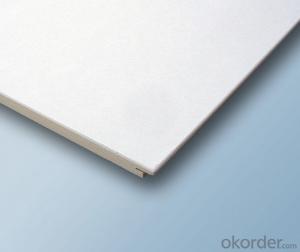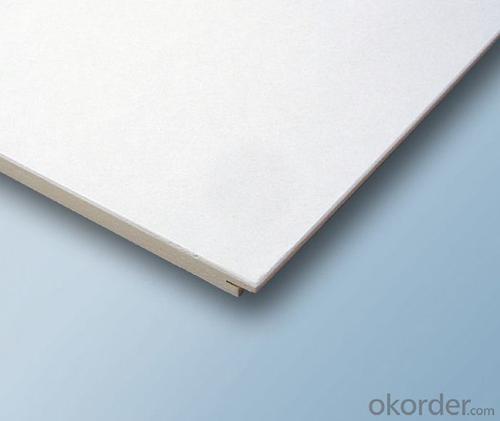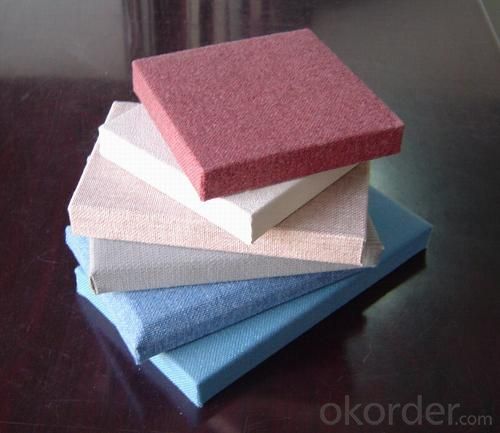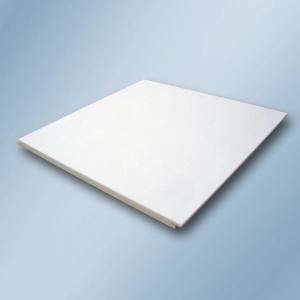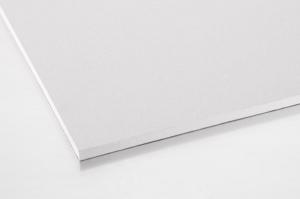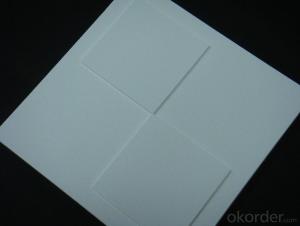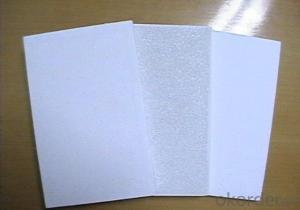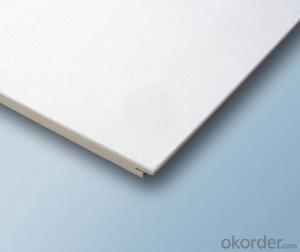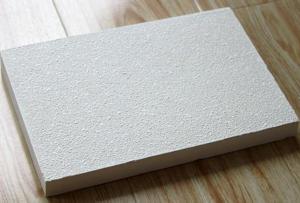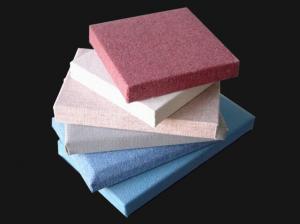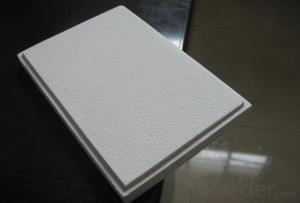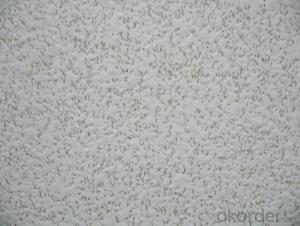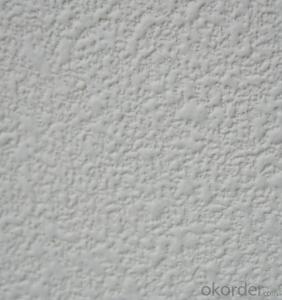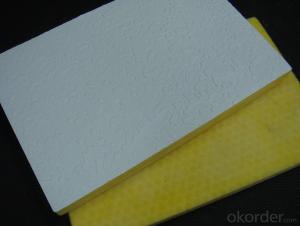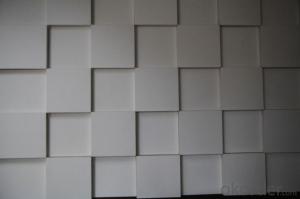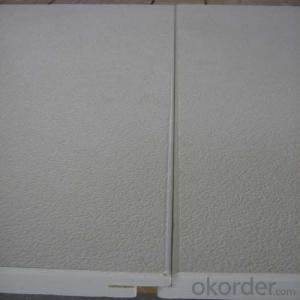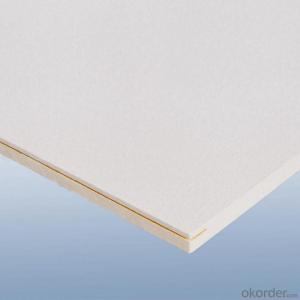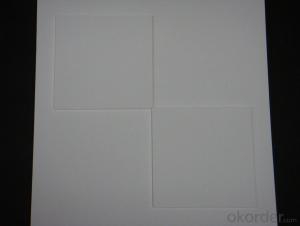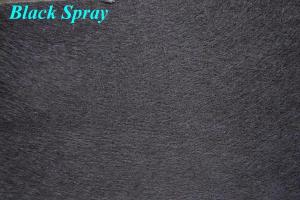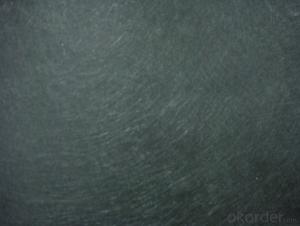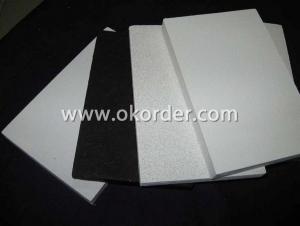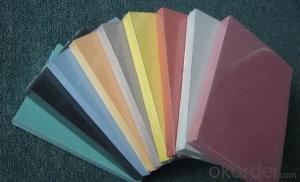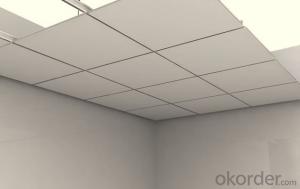Jacuzzi Fiberglass Steam Shower Ceiling - 15mm Thickness Hot Sale
- Loading Port:
- Shanghai
- Payment Terms:
- TT OR LC
- Min Order Qty:
- 4000 m²
- Supply Capability:
- 50000 m²/month
OKorder Service Pledge
OKorder Financial Service
You Might Also Like
The tiles are manufactured from high density fiberglass wool.The visible face has a decorative fiberglass tissue and the back of the tile is covered with normal tissue.The four edges of the tile are sealed and have grooves. It can be jointed together without suspended system. The tiles will cover the suspension system after installation. They are are suitable for loe flap ceiling space and concrete-made, wooded-made or gymsum ceiling.
Installation method:
Use screw to fix the smooth roof. The tiles can be connected after making grooves on each two jointed edges.
Tiles are easy to trim and install
Both inches and metric grids are available
Main Characteristic:
Non-combustible
No sagging,wrapping or delaminating
Green building material
Excellent sound absorption
Application:
Halls,classrooms,offices,shopping centers.etc.
Acoustic fiberglass ceiling contains a better perfomance in tension strong, light weight, so it is easy to trim and install for interior decoration, with T-grids for suspension system or glue, nail or good material could come with fiberglass ceiling baord. Thus an excellent artical work need a high quality acoustic ceiling board, also high quality.
Energysaving is a trend for our 21' era, new product like fiberglass ceiling tile could in place of traditional products one day. Which depends on functional characters: little deflection of geometry dimention, no radiocative property, specific activity of 226Ra: Ira ≤1.0 and specific activity of 226 Ra 232 Th, 40 K: Ir ≤ 1.3. Both products and packages can be recycled.
- Q: Kitchen ceiling (top) ceiling is good or no ceiling good?
- The age of the popular ceiling seems to have been a long time. From the original paper paste ceiling to the later gypsum board, and then to today's PVC board, PS board, mineral wool board, aluminum ceilings, etc., both the type of material and life, or decorative effect, have a great development The A few pieces of rectangular plywood, plus monotonous gypsum line and a few shining energy-saving lamps, such a ceiling who is willing to endure? Moreover, the home improvement industry has become a "minimalist" today. Whether to ceiling, what kind of ceiling, which the house of the "hanging", which should not "hanging" ... ... these are a sort of a small problem, so it is necessary to understand some of the knowledge of the ceiling.
- Q: Why is the state of magnesium dichloride at room temperature?
- Solid, is a crystal.
- Q: This is an old house and has wood and some type of dry cement-type material in between the wood slats. I stepped on the ceiling while doing an insulation job in the attic. The wood is fine but the dryed material cracked and separated from the wood slats in the bathroom. The damages area is around 18 inches by 12 inches, and some cracks in other areas of the ceiling. I do not want to sheetrock the whole bathroom if i can avaoid it (too many projects in this ol house). thanks!
- It sounds like you're describing old horsehair plaster, & fixing it's not that big of a deal, there are just a few steps involved. Basically what you need to do is to round out & stabilize your hole so that it can either be re-plastered or mostly patched w/drywall & then finished w/joint compound. The first step is re-attaching the plaster to the lathing (those wooden slats) & to do that you need these little plastic/metal washers that you can find at a good hardware/builder supply store & these are attached to drywall screws which then get screwed into the lathing a few inches away from the damage until you've got a flush surface again to work with. I'd love to tell you how many you need/etc., but it's just one of those things where you need to be there..... Anyways, once you've got a solid hole across this somewhat level surface take a beat up blade (I like using a 5 in 1) & key the damaged edges which means about a 45 degree angle so that you've got more patching material towards the lathes. It gives a more secure bond this way. Then you either screw in a piece of drywall of the appropriate thickness into the hole & patch & tape from there, or you can learn about plastering, but it doesn't sound like you want to go that route from the question. A quarter to half inch gap is fine for the patching between, & I've even used plaster of paris for the patching when I didn't want to wait for mud to dry, but that involves a learning curve to perfect, & that's your warning on that route. As far as the cracks go, take your hand & see if you can move the ceiling, & if you can then it's back to the screws & washers for the area around the cracks & that part is actually fun if necessary as you can watch a go back to being level. Then bust out the cracks a bit & patch them. A bit of fiberglass tape over the washers before you mud them helps them disappear. Have fun!
- Q: Worked putting ceiling tile in for a commercial building and on the other side of tile was yellow insulation.first time working with it didnt know any betterno gloves no mask short sleeve shirtgot it all over skin by lunch time eyes were watery itchy by the time work was over I was itching next day noticed two red sores on armjust ignored them few days later I had more places similar and itched like crazyhow do I get rid of insulation itch / rash??
- Insulation has a nasty habit of doing this to people. Fiberglass insulation is the worst, as it literally cuts the skin and causes serious rashes and enough itchy feeling that people usually draw blood from scratching so much. Water, soap, and a good scrubbing to start would be good. Watch for pain when scrubbing the area to make sure there is nothing stuck in the area that you could potentially be driving deeper into the skin. Buy some anti-itch cream in the mean time. The rash should go away with time and proper hygiene.
- Q: I want to have an illusion in my room that looks like a car falling thorught the roof. You would look up and just see, maybe the front corner of the car. It is proably hard to think of this but this is something I really want to do but have no place to look for help. Please let me know if you have any sugestions.- Amber K
- Talk to a junkyard. Buy just the front corner parts (fender, headlight, grill), cut them and screw them to a piece of plywood. Screw the plywood to the ceiling joists. OR: make a paper-mache mold of the front corner of a car, add real headlights and part of the grill. Screw to plywood, just like the other.
- Q: I am redoing my basement and am wondeirng what is the best way to insulate the basement ceiling, mainly to cut down on noise. My house is fairly old and the hardwood floors we have upstairs creak very loudly when you walk on them, and can be heard through the basement. Would fiberglass insulation work to cut down on footstep noise? If i put two layers in the ceiling would that be better? Or if I carpet upstairs would that muffle the sound?
- you need to address the problem at it's source. Installing insulation will be marginal at best as the sound waves will still travel down the joists away from the source of the squeaking. Installing pad and carpet will help upstairs to some degree, but not below. Try to identify the exact, or as close as possible, locations of the squeaking floor boards. Take some long shims ( 12 or so ), coat both sides with adhesive and gently drive them between the flooring and the joists until they are snug. Repeat as necessary. Allow to cure overnight and retest for squeaks. If any areas remain, check to be sure there is not another source of the squeaking such as bridging being loose, straps for plumbing or ductwork being loose or a cracked joist.
- Q: Home improvement, tooling need to use what decorative materials, all have their own purposes, ask you prawn
- Large construction team can be divided into hydropower, fire, air conditioning, mud, wood, paint, Each team needs the material is not a few words can be said clearly, but also what purpose, the more detailed the better? Your question is too general, haha
- Q: When I moved into my house the ceiling was cracked from the ceiling fan out to the walls in two directions. I don't want to put new wall board up and repairing the crack is not possible according to my Husband. What are some ways to cover the ceiling up?
- What you have to do is scape about 12 inches on each side of the crack. Tape and float with drywall tape and joint compound. If you have popcorn (acoustic) texture, that's better. Popcorn texture covers up all the imperfections you might leave. Once finished floating just shoot your texture. Since you probably don't have the tools. It's really not that expensive to do. Maybe$150 to $225. depending on the area your in and the size of the cracks. I recommend you get a drywall guy to come to your house and fix it, Try to get somebody to do it on a side job and not a company. Good luck. Jorge Flores Professional Painting and Remodeling co.
- Q: Not sure how to spell something that sounds like "ah-spec-tice" please tell me where I can get into on aspectice.
- I know this was posted awhile ago, but I thought this info I got from an expert may be helpful. If your house is built before 1978 it may have asbestos. To remove popcorn ceilings before this date the cheap way is to layer plastic everywhere in the area of the popcorn ceiling use a spray bottle or mister keeping it wet then scrape it off. When finished gather the plastic up keeping the popcorn ceiling remains encased in the plastic put it in a large garbage bag, seal up, and toss it. The key is to keep it wet when removing. For extra precaution wear safety glasses and mask. As long as it's wet it can't be inhaled and that's when it's dangerous. If you think it may be in the walls it's a good idea to get your home tested for the professionals to come in to clean it but it will cost you a lot of money.
- Q: What is the specific waterproofing of the bathroom? How much is the height of the wall As well as craftsmanship?
- Polyurethane waterproof coating general approach is as follows: 1, the ground to the direction of the ground to find slope, cement mortar or bean concrete can be, but the surface to be flat. Near the door slope is small, the gap near the slope, according to the specific situation to master. 2, the pipeline to wear the floor of the root, to strengthen the waterproof. Tube root construction seal seal, cement smoothing foot protection, brush waterproof coating when the paste from the wire to strengthen the layer 1 to 2 layers. The same measures around the floor drain. 3, the wall to deal with clean plain light without floating ash, small particles, wall ground junction to wipe the original angle or slope angle. Brush waterproof coating when the glass cloth to strengthen the layer 1 to 2 layers. 4, the total thickness of polyurethane waterproof coating requires more than 1.5 mm. Can not rely on the number of decisions. Root, corner reinforcement layer at the first brush, room temperature 4h dry, and then a large area of ??brushing, Tu scraping. There is no leakage scraping, bubbling phenomenon. Large area brushing 24h curing after brushing the next layer. 5, first brushing the facade after brushing the plane, the next brushing direction and the vertical again. The last time the film semi-curing, throwing coarse sand particles, easy to combine with the cement mortar in the future. 6, the ground waterproof layer should be painted out of the bathroom door outside the 300 wide. Waterproof surface waterproof layer should be higher than the ground 200, a shower bathroom wall waterproof layer should be higher than the ground 1800 (L8 recommended full wall waterproof).
Send your message to us
Jacuzzi Fiberglass Steam Shower Ceiling - 15mm Thickness Hot Sale
- Loading Port:
- Shanghai
- Payment Terms:
- TT OR LC
- Min Order Qty:
- 4000 m²
- Supply Capability:
- 50000 m²/month
OKorder Service Pledge
OKorder Financial Service
Similar products
Hot products
Hot Searches
Related keywords
